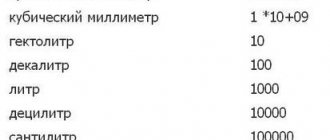One cube of gasoline (1 m3 of gasoline) contains 0.75 tons.
There are 1.33 cubic meters in one ton of gasoline.
To convert tons to cubes and back, use the online calculator for converting tons to cubes (you need to know the density for the calculation).
How is the calculation made:
The calculation is made using a simple physical formula: Mass = Density * Volume.
The density of gasoline depends on the type of gasoline and is approximately 750 kg/m3.
1) If you need to determine the mass of gasoline, then multiply the density of gasoline by its volume.
2) If you need to determine the volume of gasoline, then divide the mass of gasoline by its density.
Theoretical and practical concepts of converting one unit of measurement into another are based on centuries of experience in scientific research of mankind in applied fields of knowledge.
Mass is a characteristic of a body, which is a measure of gravitational interaction with other bodies.
Volume is the amount of space occupied by a body or substance.
Density is a physical quantity defined as the ratio of the mass of a body to the volume occupied by this body.
This page provides the simplest answer to the question of how many tons of gasoline are in a cube and vice versa. One cubic meter of gasoline is equal to 0.75 tons. One ton of gasoline is equal to 1.33 cubic meters.
Anyone who studied well at school and understood physics knows that the volume of any liquid substance can depend on two parameters - mass and density. If these quantities are known, then it can be calculated. Knowing the density, we can determine how many liters of diesel fuel are in 1 ton. However, it is worth noting that the density of diesel fuel cannot be standard - it varies depending on the ambient temperature. Therefore, in winter there will be fewer liters of fuel in one ton, and more in summer.
What is the weight of 1 liter of diesel fuel?
Weight of 1 liter (1 dm3) of diesel fuel (diesel fuel, diesel fuel) at a temperature of +20 0C: - summer - up to 0.860 kg; — winter — up to 0.840 kg; - Arctic - up to 0.830 kg.
Interesting materials:
How can I clean the teapot? What can you use to wipe off sticky tape? How can I remove tape marks from plastic? How can you cut a dog's hair? How can you dye a white leather bag? How can you paint pebbles? How can you water a tree to make it disappear? How can I glue a plastic corner? How can you dissolve paper in the toilet? How can you dilute Amaretto liqueur?
Density of different types of diesel fuel
Everything is divided into different types and is not standard. There are at least three types: summer, winter, arctic fuel. The density is different, and in order to calculate how many liters of diesel fuel are in 1 ton, we need to know this value.
So, summer diesel fuel has a density of 860 kg/m3. This diesel fuel is distinguished by its operating temperature range. At 10 degrees above zero, this fuel may begin to solidify. The temperature at which an outbreak is possible is 45 degrees above zero. It is usually sold in hot countries.
Winter diesel fuel has a density of 840 kg/m3. It does not harden at temperatures not lower than -35 degrees. Therefore, this fuel is effective in winter. Ignition is possible at 40 degrees Celsius.
There is also Arctic diesel fuel, which is rarely found at gas stations in the city. Its density is 830 kg/m3. It can ignite at 35 degrees Celsius.
If this product is sold in large volumes, the calculation is made in tons, not in liters. This is because liquid can contract or expand at low and high temperatures, respectively. Consequently, the volume will increase or decrease, but the mass will remain constant. Of course, you can buy it in liters, but then there may be a high error for better or worse for the buyer or seller.
Diesel fuel density standards kg/l
The density of diesel fuel refers to its mass, which fits in one cubic meter. It is regulated by GOST 305-82 and GOST R 52368-2005.
Oil refineries produce diesel fuel, which is certified by the relevant authorities for all characteristics. If the density does not correspond to the indicator prescribed in the state standard, diesel fuel does not receive a quality certificate and is not allowed on the market for sale.
The density of diesel fuel, depending on the brand, is established by the standards as follows:
- winter – 860 kg/m3;
- summer - 840 kg/m3;
- Arctic – 830kg/m3.
The increased density of diesel fuel indicates the presence of heavy fractions in its composition, which significantly complicate the operation of the internal combustion engine. As a result of using fuel with increased density, carbon deposits form on the walls of the combustion chamber.
The density of diesel fuel also indicates the amount of energy released as a result of its combustion. Denser fuel releases more energy, which increases the efficiency of the power unit. Due to its higher density, summer diesel fuel is more economical than winter diesel fuel, which has a relatively low density.
To calculate the volume of diesel fuel in liters, you need to divide its mass by its density. In 1 ton of winter fuel there will be 1163 liters of diesel fuel, in a ton of summer fuel - 1190. The volume of diesel fuel is constantly changing and depends on certain factors.
Delivery of diesel fuel without deception:
Conversion of diesel fuel: liters to tons
In order to recalculate diesel fuel, you need to apply the following formula:
This formula is for determining volume. It follows from this that the mass will be equal to:
- V—volume (liters);
- M—mass (tons or kilograms);
- p—density.
The density for different types of diesel fuel is already indicated above. It must be substituted for the p value. With two known quantities, we can easily calculate how many liters are in 1 ton of diesel fuel, or vice versa.
We also note that the Ministry of Industry and Energy of the Russian Federation averaged the density of diesel fuel for accurate recalculation. It is 0.769 kg/liter. It must be used for recalculation.
How many liters of diesel fuel are in 1 ton?
Taking into account the known density of different types of diesel fuel, you can easily calculate how many liters a ton contains. So, summer fuel has a density of 860 kg/m3. That is, one thousand liters contains 860 kg. This means that 1000 kg of summer diesel fuel will have a volume of 1162.8 liters. This is exactly the container needed to fill one ton of fuel.
As for winter diesel fuel, its density is 840 kg/m3. Therefore, 1000 liters contain 840 kg. One ton of such fuel will have a volume of 1190.5 liters. As for Arctic diesel fuel, one ton of it will fit in a container with a volume of 1204 liters.
How many liters are in 1 cubic meter of diesel fuel?
A cubic meter is a unit of volume. It does not depend on the brand of diesel fuel or liquid temperature. There are always 1000 liters in 1 m3.
| Recalculate, find out volumetric weight: physical properties. | Quantities. | Amount of kg in 1 liter, kg/liter. | For calculations, reference data was used from: | Now you can find out how much it weighs using a tool such as: | Measurement error. | — |
| How many kg does 1 liter of diesel fuel weigh in a liter can? | We use reference data on density and specific gravity, calculating using the formula to obtain the volumetric weight. | 0.821 — 0.861 | Directory of physical properties, GOST, TU. | Liter jar. | up to 5% | — |
Classification of diesel fuel
Today, each country has its own quality standards for diesel fuel, but there are main classification categories that are common to any type of diesel fuel, prescribed in interstate GOSTs 32511-2013 (EN 590:2009), 305-2013 and 2517-2012.
There are low-viscosity fuels (distillate), used for high-speed engines, and residual, low-viscosity fuels. Unlike hydrotreated kerosene-gas oil fractions of discilate fuel, the residual consists of a mixture of fuel oil and kerosene-gas oil fractions.
The main principle of classification is seasonality.
It can only be used at positive temperatures. The specific gravity of summer diesel is 860 kg/m3 (the theoretical density of any type of diesel fuel is determined at +20ºС). With increasing temperature, the specific gravity decreases by approximately 0.0007 g/cm3, and with decreasing temperature, it increases accordingly.
At a temperature of -5ºС, the paraffins of summer diesel fuel thicken and clog the system. The use of additives helps delay thickening, but they do not change the increased density of summer fuel at subzero temperatures. Flash point 62ºС.
It is recommended to use in the negative temperature range of 45-50ºС. The density of diesel is 830 kg/m3, and the flash point is +35 degrees Celsius. DF A is obtained by dewaxing summer DF or by adding cetane-increasing additives and motor oil to pure kerosene to improve lubricating properties.
Weight of diesel fuel in 1 liter
is approximately 850 g or 0.85 kg
Diesel weight table
| Type of diesel engine | Temperature range (ºС) | Density (kg/m3) | Specific gravity (g/cm3) |
| Summer | +0 … | 860 | 0,86 |
| Winter | -35… -20 | 840 | 0,84 |
| Arctic | -50…-45 | 830 | 0,83 |
Volumes in cooking
Liquids in cooking recipes are usually measured by volume. Bulk and dry products in the metric system, on the contrary, are measured by mass.
Tea spoon
The volume of a teaspoon is different in different measurement systems. Initially, one teaspoon was a quarter of a tablespoon, then - one third. It is the latter volume that is now used in the American measurement system. This is approximately 4.93 milliliters. In American dietetics, the size of a teaspoon is 5 milliliters. In the UK it is common to use 5.9 millilitres, but some diet guides and cookbooks use 5 millilitres. The size of a teaspoon used in cooking is usually standardized in each country, but different sizes of spoons are used for food.
Tablespoon of milk
Tablespoon
The volume of a tablespoon also varies depending on the geographic region. So, for example, in America, one tablespoon is three teaspoons, half an ounce, approximately 14.7 milliliters, or 1/16 of an American cup. Tablespoons in the UK, Canada, Japan, South Africa and New Zealand also contain three teaspoons. So, a metric tablespoon is 15 milliliters. A British tablespoon is 17.7 milliliters, if a teaspoon is 5.9, and 15 if a teaspoon is 5 milliliters. Australian tablespoon - ⅔ ounce, 4 teaspoons, or 20 milliliters.
Cup
As a measure of volume, cups are not defined as strictly as spoons. The volume of the cup can vary from 200 to 250 milliliters. A metric cup is 250 milliliters, and an American cup is slightly smaller, approximately 236.6 milliliters. In American dietetics, the volume of a cup is 240 milliliters. In Japan, cups are even smaller - only 200 milliliters.
Quarts and gallons
Gallons and quarts also have different sizes depending on the geographic region where they are used. In the Imperial system of measurement, one gallon is equal to 4.55 liters, and in the American system of measurements - 3.79 liters. Fuel is generally measured in gallons. A quart is equal to a quarter of a gallon and, accordingly, 1.1 liters in the American system, and approximately 1.14 liters in the Imperial system.
Pint
Pints are used to measure beer even in countries where the pint is not used to measure other liquids. In the UK, milk and cider are measured in pints. A pint is equal to one-eighth of a gallon. Some other countries in the Commonwealth of Nations and Europe also use pints, but since they depend on the definition of a gallon, and a gallon has a different volume depending on the country, pints are also not the same everywhere. An imperial pint is approximately 568.2 milliliters, and an American pint is 473.2 milliliters.
8 fluid ounces or 235 milliliters liquid cream tube
Fluid ounce
An imperial ounce is approximately equal to 0.96 US ounces. Thus, an imperial ounce contains approximately 28.4 milliliters, and an American ounce contains 29.6 milliliters. One US ounce is also approximately equal to six teaspoons, two tablespoons, and one eighth cup.
Volume calculation
Liquid displacement method
The volume of an object can be calculated using the fluid displacement method. To do this, it is lowered into a liquid of a known volume, a new volume is geometrically calculated or measured, and the difference between these two quantities is the volume of the object being measured. For example, if when you lower an object into a cup with one liter of water, the volume of the liquid increases to two liters, then the volume of the object is one liter. In this way, you can only calculate the volume of objects that do not absorb liquid.
How to calculate how many liters of gasoline are in a ton?
V = 1000: 755 = 1.32 liters, but to correspond with tonnage, and not with kilograms, multiply the result by 1000. So gasoline, weighing 1 ton, corresponds to an occupied volume of 1320 liters.
Interesting materials:
Who came up with the story about the goldfish? Who invented the fairy tale about Cinderella? Who flew to the swamp in Garshin's fairy tale the frog traveler? Who cooked porridge from an ax in the fairy tale Porridge from an Ax? Who is Gerda in the fairy tale The Snow Queen? Who is the queen from the fairy tale 12 months? Who pulled the turnip from the fairy tale? Who pulled the turnip in the fairy tale turnip? Who told the poet fairy tales as a child? Who is in the Tale of the Dead Princess?
Why is this even needed?
Why do people need to know how many liters of diesel fuel are in 1 ton? Everything is simple when it comes to buying small volumes of diesel fuel: we arrived at the gas station, filled the tank full and drove on. However, not all so simple. Companies that purchase large volumes of fuel calculate in other units of measurement - tons or kilograms. And this is completely logical, because the volume of diesel fuel is not a constant quantity and can change. For example, a person will buy 500 liters of fuel in the summer when it’s hot, but in the fall when it gets cold it turns out that there are only 450 liters left in the tank. It turns out that he overpaid the seller 50 liters. And if payment was made for kilograms or tons, then nothing like this would happen, and no one would be at a loss, since the weight remains unchanged.










